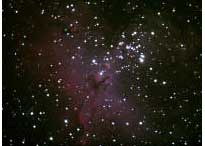
The Eagle Nebula
Stars don’t last forever, though they do last for billions of years. And they don’t stay the same throughout their existence – they change over time.
The earliest beginning of a star is called a nebula. A nebula is a cloud of hydrogen and a few helium atoms hanging in space. Sometimes a nebula just stays at this point. But if the cloud gets thick enough, with enough hydrogen atoms close enough together, it can become a brown dwarf. A brown dwarf is a small star that is not quite big enough, so there is not enough gravity to start the nuclear fusion process. Brown dwarf stars hardly shine at all, but they’re not very common either.

What a brown dwarf might look like up close
If the brown dwarf succeeds in attracting enough hydrogen atoms and packing them tightly enough together, then it turns into a main-sequence star. That’s an ordinary star like our sun. Nine out of every ten stars you can see from Earth are main-sequence stars. Inside a main-sequence star, the pressure of gravity pushes hydrogen atoms together so they become helium atoms. And the extra energy released by this fusion process shoots out of the star and become heat and sunlight.

The red giant star Betelgeuse (thanks to Hubble Space Telescope)
A main-sequence star usually doesn’t change for several billion years. But eventually it runs out of hydrogen atoms to turn into helium atoms, like a car running out of gas. When this happens, the main-sequence star turns into a supergiant star. These supergiants, or “red giants”, are much bigger and cooler than regular stars. Two examples of supergiant stars are Antares and Betelgeuse. Supergiant stars still have nuclear fusion going on inside them, but they change helium atoms into carbon, or carbon into oxygen. A supergiant lasts about one-tenth as long as the main-sequence star did.

Supernova (from NASA)
When all of the atoms inside the supergiant star are done changing into heavier atoms, they end up as a big lump of iron in the center of the star. When this happens, the supergiant explodes in a huge supernova. After the supernova is done exploding, it leaves behind a tiny, dense star with a lot of atoms crowded into a very small space. This is a white dwarf. All around the white dwarf, there’s a big cloud of dust from the supernova’s explosion. This is a new nebula, and after about ten thousand years it will recycle the old star’s atoms into a new star. Eventually the white dwarf will cool off completely and become a black dwarf.
The biggest stars, the ones at least eight times as big as our sun, behave a little differently. When the supergiant collapses, instead of a white dwarf, you get a nebula and a neutron star or a black hole. Then the nebula gets to work making itself into a new star.
More about stars
Bibliography and further reading about stars:




